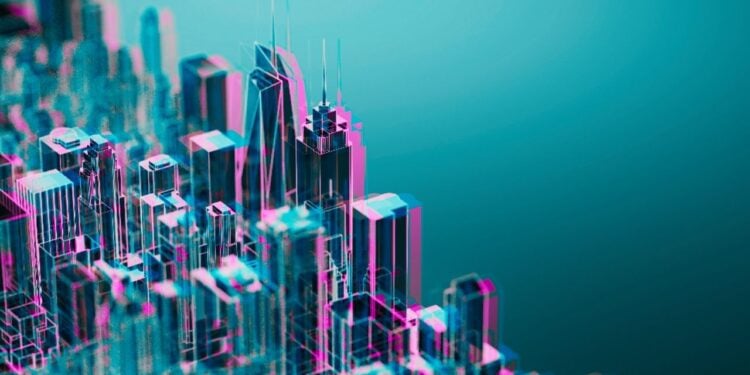- AI’s impact is broad, but one of its most transformative applications is unfolding in the design of our work environments.
- AI’s value isn’t only about the worker experience — it significantly contributes to operational efficiency and sustainability.
- AI promises a revolution in architectural design and the workplace experience.
This article was originally written by Gensler’s Christian Lehmkuhl for Work Design Magazine.
In an era where technology is consistently pushing boundaries, the rise of artificial intelligence is heralding an exciting evolution in architectural design, particularly in the workplace. AI is not merely a futuristic concept; it’s a game-changer that is redefining the everyday experience of employees in profound ways.
AI’s impact is broad, but one of its most transformative applications is unfolding in the design of our work environments. This is not a futuristic concept; it’s a paradigm shift that’s radically reshaping the way employees experience their workspaces. AI is becoming the unseen yet crucial pillar, bolstering the future of work.
Reimagining Workspaces with AI
While the integration of AI into architecture is still maturing, its potential is undeniable. Its prowess in intricate design rendering and computational problem-solving has propelled architects into a new realm of creative possibility.
AI’s most potent asset is its capacity for predictive analysis. When this ability is applied to architectural design, it unveils a new dimension in workspace optimization. Architects and designers can input variables—such as building orientation, materials, local climate data, and energy consumption—into AI algorithms, yielding concepts that prioritize energy efficiency and sustainability.
This analytical prowess also makes AI an invaluable tool for workspace utilization. By tracking data on employee movement and interaction, AI can suggest designs that enhance collaboration, productivity, and well-being. The insights gleaned from such analysis can aid in the creation of efficient layouts that boost employee satisfaction while curtailing costs.
The AI-Powered Experience Revolution
In an era of rapid change, the contours of the workplace are being redrawn at an unprecedented pace. Across the globe, we’ve seen a fundamental shift in how and where work happens.
To compete for the best talent, and attract their workforce back into the physical office, corporations are asked to foster an environment that provides appeal beyond the traditional office space. What truly distinguishes the victors in this war for talent, is not just the physical spaces they provide, but the meticulously crafted experiences they curate for their employees.
AI’s key attribute in this context is its ability to create adaptive workspaces tailored to individual preferences. AI-controlled systems can adjust temperature, lighting, and ambient noise levels, creating a conducive atmosphere for each employee. This personalization extends to AI-powered digital assistants that manage schedules, remind individuals of tasks, and even provide traffic updates, acting as a personal “workplace concierge.”
The integration of AI into the workplace does more than just streamline tasks; it fosters continuous learning and development. By mapping abilities and proposing upskilling programs, AI enables employees to take control of their career growth trajectories. It even encourages employees to take short breaks or engage in mindful exercises, contributing to a healthier work culture.
Envisioning a Day in an AI-Enhanced Office
As a person steps into the office of the future, they could be greeted by an advanced AI assistant. Instead of merely scanning an ID badge, AI recognizes faces, welcomes them with a personalized message that includes an overview of a schedule, weather updates, and any notable news or emails.
A workday begins not with the task of sifting through emails, but with a prioritized list of tasks and meetings, generated by an AI assistant. AI not only considers deadlines but also understands the most productive times of the day, ensuring that high-priority tasks align with peak productivity periods. It also schedules breaks at optimal intervals to prevent fatigue and maintain mental well-being.
Meeting rooms in this AI-enhanced office are dynamic. The AI system recognizes the meeting’s nature and the participants, adjusting lighting, temperature, and even noise levels to create a favorable environment. For creative brainstorming sessions, the room could have a warm, inviting ambiance, while for strategy meetings, the environment might be cooler and more formal.
Collaboration is made seamless with AI-powered virtual whiteboards that capture and transcribe discussions, assign action items, and even translate conversations in real-time to ensure all members, regardless of language, are on the same page.
In this futuristic workspace, AI also takes the lead in ensuring physical well-being. Sit-stand desks and ergonomic chairs self-adjust to ideal settings. AI monitors posture, reminding a person to adjust if they have been sitting improperly or standing for too long. There are even AI-guided wellness breaks, with exercises designed to relieve stress and enhance concentration.
AI will also revolutionize learning and development in the workplace. AI-driven personalized learning programs will consider an employee’s current skill level, learning style, and career ambitions to curate a unique learning pathway, ensuring continual growth and adaptation to the evolving business landscape.
The end of the day doesn’t mean the end of AI’s role. As a person leaves, the system remembers preferences, preparing for the next day at work. The smart system also coordinates with AI at home, adjusting a person’s return journey for weather or traffic, and communicating to ensure that home is ready for arrival.
Operational Efficiency and Sustainability through AI
AI’s value isn’t only about the worker experience — it significantly contributes to operational efficiency and sustainability. AI systems can optimize energy usage and reduce waste, which is a crucial feature in the quest for sustainable workplaces.
Predictive maintenance, powered by AI, can predict equipment failures, minimizing disruption and lowering maintenance costs. The enhanced security offered by AI, from recognizing unusual activity to identifying potential hazards, makes workplaces safer.
The Ethical Path to AI Integration
The ethical implications of AI integration can’t be overlooked. As we move into an increasingly data-driven world, privacy and data security need to be managed judiciously to ensure that the benefits of AI don’t come at the cost of personal information misuse.
Further, AI should complement human ingenuity, not replace it. A human-centric approach to AI integration is essential to maintain a balance between automation and human interaction.
AI promises a revolution in architectural design and the workplace experience. Its goal isn’t to create automated, impersonal workspaces, but rather efficient, sustainable environments tailored to individual needs. By blending technological innovation with a human-centric approach, AI can shape workplaces that nurture creativity, collaboration, and well-being. These workplaces are more than just physical structures—they are dynamic ecosystems that adapt, learn, and evolve.


 Dr. Gleb Tsipursky – The Office Whisperer
Dr. Gleb Tsipursky – The Office Whisperer Nirit Cohen – WorkFutures
Nirit Cohen – WorkFutures Angela Howard – Culture Expert
Angela Howard – Culture Expert Drew Jones – Design & Innovation
Drew Jones – Design & Innovation Jonathan Price – CRE & Flex Expert
Jonathan Price – CRE & Flex Expert























